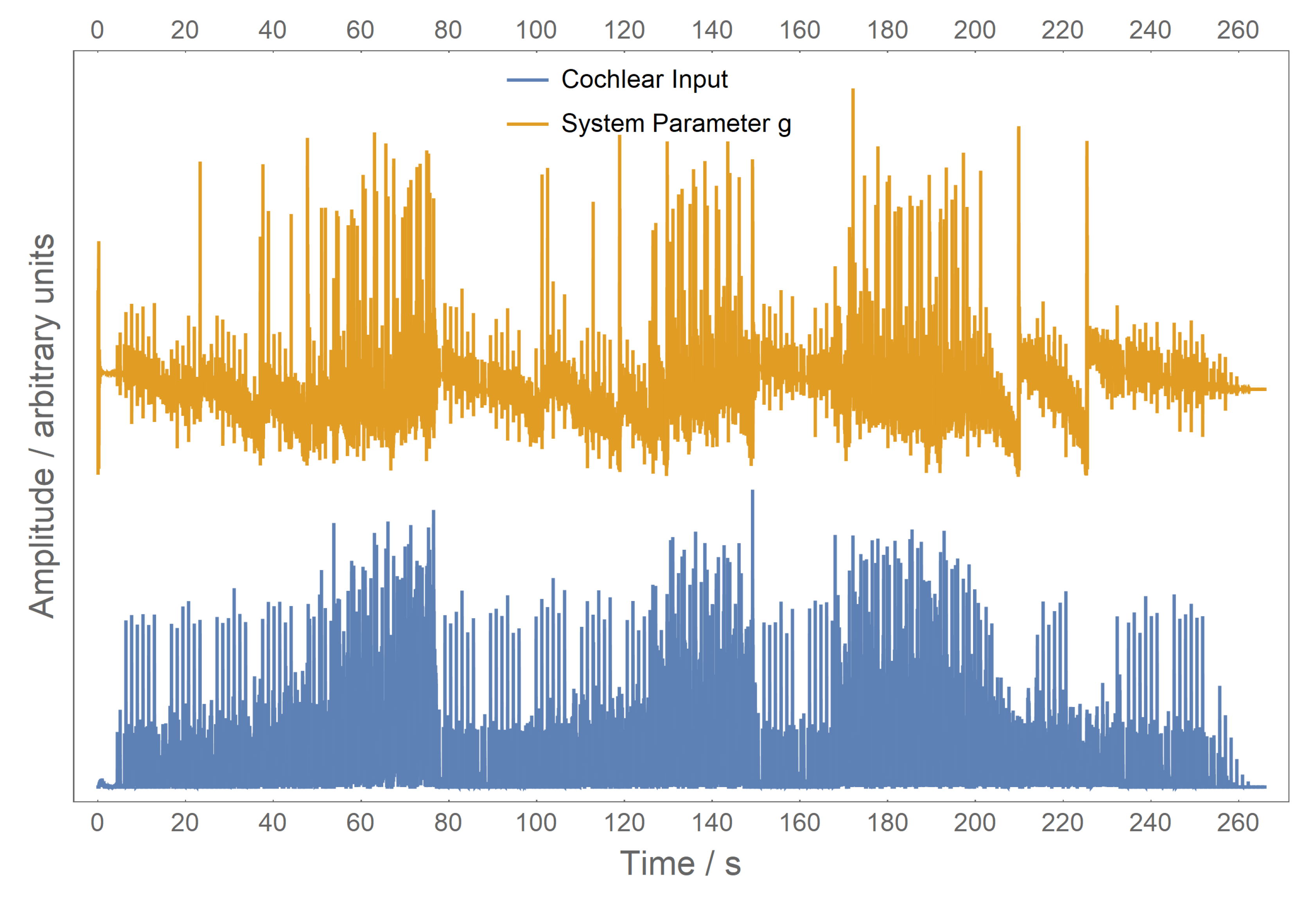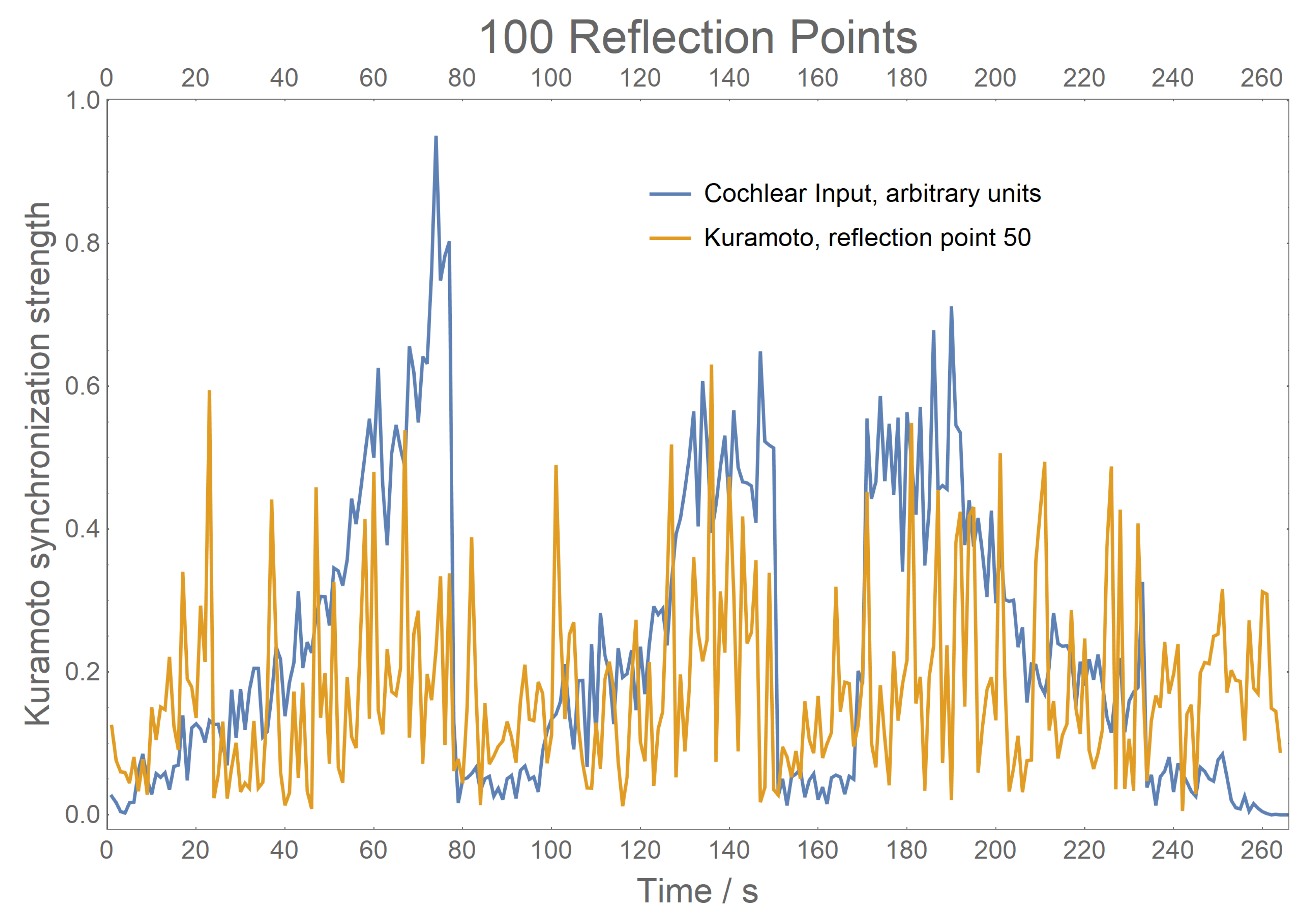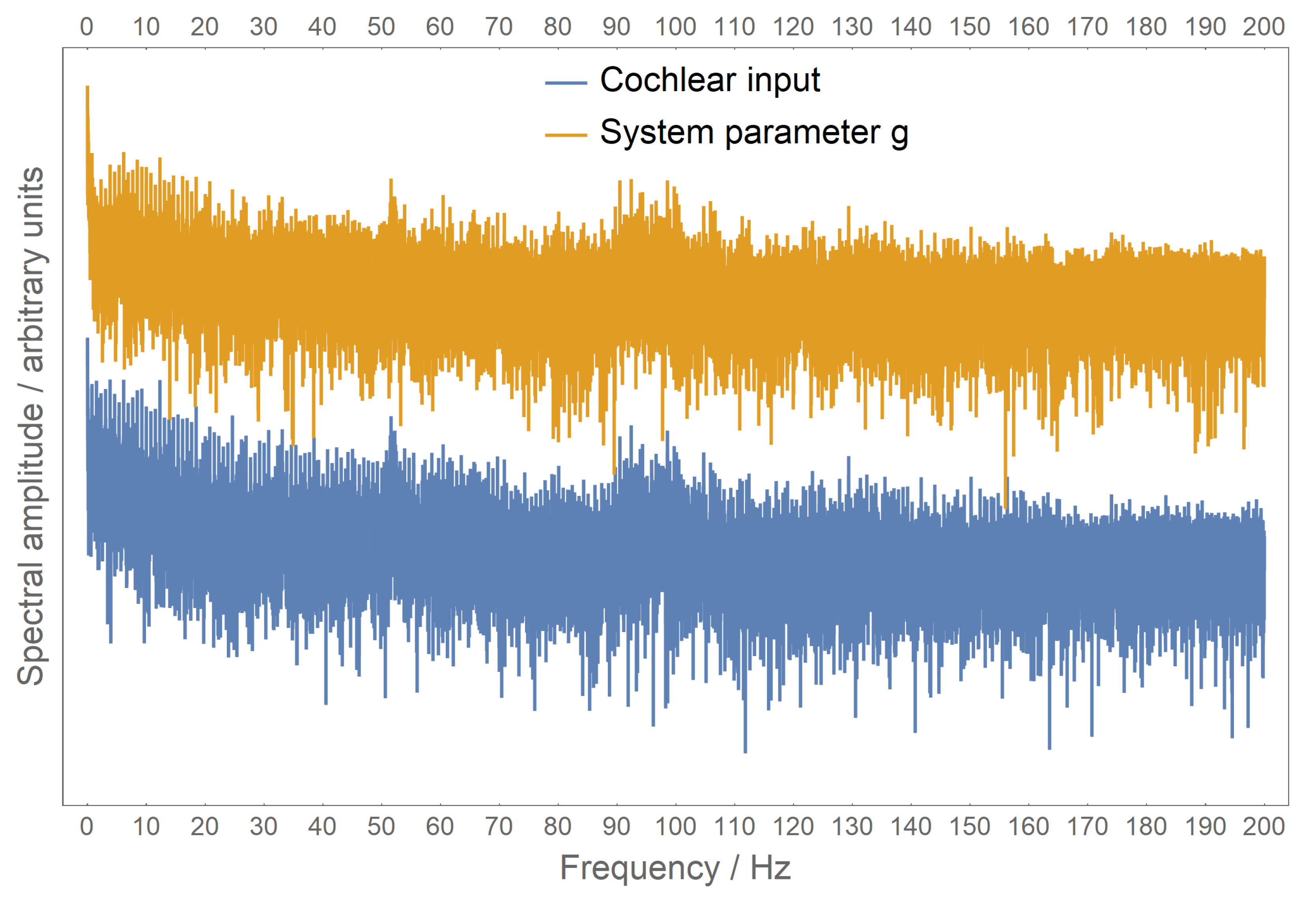Modeling Temporal Lobe Epilepsy during Music Large-Scale Form Perception Using the Impulse Pattern Formulation (IPF) Brain Model
Abstract
1. Introduction
2. Methods
2.1. Cochlea Model
2.2. Brain Impulse Pattern Formulation (IPF)
2.3. Plasticity Model
2.4. External Musical Instrument Input IPF
2.5. Detection of System Behavior
3. Results
3.1. System Behavior
3.2. Gamma Band Synchronization Strength
3.3. Scaling Law
4. Conclusions and Discussion
Funding
Institutional Review Board Statement
Data Availability Statement
Acknowledgments
Conflicts of Interest
References
- Hartmann, L.; Bader, R. Neural Synchroniztaion of Music Large-Scale Form. arXiv 2020, arXiv:2005.06938. [Google Scholar]
- Hartmann, L. Neuronal synchronization of musical large-scale form: An EEG-study. Proc. Mtgs. Acoust. 2014, 22, 035001. [Google Scholar] [CrossRef]
- Bregman, A.S. Auditory Scene Analysis: The Perceptual Organization of Sound; MIT Press: Cambridge, MA, USA, 1990. [Google Scholar]
- Leman, M.; Carreras, F. Schema and Gestalt: Testing the hypothesis of Psychoneural Isomorphism by Computer Simulation. In Music, Gestalt, and Computing. Studies in Cognitive and Systematic Musicology; Leman, M., Ed.; Springer: Berlin/Heidelberg, Germany, 1997; pp. 144–168. [Google Scholar]
- Deutsch, D. The Psychology of Music, 3rd ed.; Academic Press series in cognition and perception; Academic: Oxford, UK, 2013. [Google Scholar]
- Deliège, I.; Mélen, M. Cue abstraction in the representation musical form. In Perception and Cognition of Music; Deliège, I., Sloboda, J.A., Eds.; Psychology Press: Hove, UK, 2014; pp. 387–412. [Google Scholar]
- Lerdahl, F.; Jackendoff, R. A Generative Theory of Tonal Music, 4th ed.; The MIT Press Series on Cognitive Theory and Mental Representation; MIT Press: Cambridge, MA, USA, 1990. [Google Scholar]
- Cuddy, L.L. Long-Term Memory for Music. In Springer Handbook of Systematic Musicology; Bader, R., Ed.; Springer: Berlin/Heidelberg, Germany, 2018; pp. 453–459. [Google Scholar]
- Bader, R. Cochlea spike synchronization and coincidence detection model. Chaos 2018, 23105, 1–10. [Google Scholar]
- Pressnitzer, D.; de Cheveigne, A.; McAdams, S.; Collet, L. (Eds.) Auditory Signal Processing: Physiology, Psychoacoustics, and Models; Springer: New York, NY, USA, 2004. [Google Scholar]
- Cariani, P. Temporal Codes, Timing Nets, and Music Perception. J. New Music. Res. 2001, 30, 107–135. [Google Scholar] [CrossRef]
- Bader, R. How Music Works. A Physical Culture Theory; Springer: Berlin/Heidelberg, Germany, 2021. [Google Scholar]
- Hawkins, L.H.; McMullen, T.H.; Popper, A.N.; Fay, R. (Eds.) Auditory Computation; Springer Handook of Auditory Research; Springer: New York, NY, USA, 1996. [Google Scholar]
- Kacprzyk, J.; Pedrycz, W. (Eds.) Springer Handbook of Computational Intelligence; Springer: Berlin/Heidelberg, Germany, 2015. [Google Scholar]
- Friston, K.J.; Friston, D.A. A Free Energy Formulation of Music Performance and Perception. Helmholtz Revisited. In Sound—Perception—Performance; Bader, R., Ed.; Springer Series: Current Research in Systematic Musicology; Springer: Berlin/Heidelberg, Germany, 2013; Volume 1, pp. 43–70. [Google Scholar]
- Baars, B.J.; Franklin, S.; Ramsoy, T.Z. Global workspace dynamics: Cortical binding and propagation enable conscious contents. Front. Psychol. 2013, 4, 200. [Google Scholar] [CrossRef]
- Haken, H. Brain Dynamics, 2nd ed.; Springer Series in Synergetics; Springer: Berlin/Heidelberg, Germany, 2008. [Google Scholar]
- Grossberg, S. Adaptive pattern classification and universal recording I: Parallel development and coding of neural feature detectors. Biol. Cybernitics 1976, 23, 121–134. [Google Scholar] [CrossRef] [PubMed]
- Grossberg, S. Adaptive pattern classification and universal recording II: Feedback, expectation, olfaction, and illusion. Biol. Cybernitics 1976, 23, 187–202. [Google Scholar] [CrossRef]
- Gjerdingen, R.O. Categorization of musical patterns by selforganizing neuronlike networks. Music. Percept. 1990, 8, 339–370. [Google Scholar] [CrossRef]
- Briot, J.-P.; Hadjeres, G.; Pachet, F.-D. Deep Learning Techniques for Music Generation; Springer: Berlin/Heidelberg, Germany, 2020. [Google Scholar]
- Bader, R. (Ed.) Compuational Phonogram Archiving; Springer Series: Current Research in Systematic Musicology; Springer: Berlin/Heidelberg, Germany, 2019; Volume 5. [Google Scholar]
- Blass, M.; Fischer, J.; Plath, N. Computational Phonogram Archiving: A generic framework for knowledge discovery in music archives. Phys. Today 2020, 73, 50–55. [Google Scholar] [CrossRef]
- Kozma, R.; Freeman, W.J. (Eds.) Cognitive Phase Transitions in the Cerebral Cortex—Enhancing the Neuron Doctrine by Modeling Neural Fields; Springer Series Studies, System, Decision, and Control; Springer: Berlin/Heidelberg, Germany, 2016. [Google Scholar]
- Ohl, F.W. On the Creation of Meaning in the Brain—Cortical Neurodynamics during Category Learning. In Cognitive Phase Transitions in the Cerebral Cortex—Enhancing the Neuron Doctrine by Modeling Neural Fields; Kozma, R., Freeman, W.J., Eds.; Springer Series Studies, System, Decision, and Control; Springer: Berlin/Heidelberg, Germany, 2016; pp. 147–159. [Google Scholar]
- Ohl, F.W.; Scheich, H.; Freeman, W.J. Change in pattern of ongoing cortical activity with auditory category learning. Nature 2001, 412, 733–736. [Google Scholar] [CrossRef] [PubMed]
- Freeman, W. A Socitey of Brains; Psychology Press: London, UK, 2014. [Google Scholar]
- Bader, R. Impulse Pattern Formulation (IPF) Brain Model. arXiv 2022, arXiv:2212.11021. [Google Scholar]
- Bader, R. Nonlinearities and Synchronization in Musical Acoustics and Music Psychology; Current Research in Systematic Musicology; Springer: Berlin/Heidelberg, Germany, 2013; Volume 2. [Google Scholar]
- Linke, S.; Bader, R.; Mores, R. The impulse pattern formulation (IPF) as a model of musical instruments—Investigation of stability and limits. Chaos 2019, 29, 103109. [Google Scholar] [CrossRef] [PubMed]
- Linke, S.; Bader, R.; Mores, R. Modeling synchronization in human musical rhythms using Impulse Pattern Formulation (IPF). arXiv 2021, arXiv:2112.03218. [Google Scholar]
- Buzsáki, G. Rhythms of the Brain; Oxford University Press: Oxford, UK, 2006. [Google Scholar]
- Sawicki, J.; Hartmann, L.; Bader, R.; Schöll, E. Modelling the perception of music in brain network dynamics. Front. Netw. Physiol. 2022, 2, 910920. [Google Scholar] [CrossRef] [PubMed]
- Buhusi, C.V.; Meck, W.H. What makes us tick? Functional and neural mechanisms of interval timing. Nat. Rev. Neurosci. 2005, 6, 755–765. [Google Scholar] [CrossRef] [PubMed]
- Gerster, M.; Berner, R.; Sawicki, J.; Zakharova, A.; Škoch, A.; Hlinka, J.; Lehnertz, K.; Schöll, E. FitzHugh-Nagumo oscillators on complex networks mimic epileptic seizure-related synchronization phenomena. Chaos 2020, 30, 123130. [Google Scholar] [CrossRef] [PubMed]
- Omelchenko, I.; Omelćhenko, O.E.; Hövel, P.; Schöll, E. When nonlocal coupling between oscillators becomes stronger: Patched synchrony or multichimera states. Phys. Rev. Lett. 2013, 110, 224101. [Google Scholar] [CrossRef] [PubMed]
- McCrae, N.; Elliott, S. Spiritual experiences in temporal lobe epilepsy: A literature review. Br. J. Neurosci. Nurs. 2012, 8, 346–351. [Google Scholar] [CrossRef]
- Babbs, C.F. Quantitative Reappraisal of the Helmholtz-Guyton Resonance Theory of Frequency Tuning in the Cochlea. J. Biophys. 2011, 2011, 435135. [Google Scholar] [CrossRef] [PubMed][Green Version]
- Liu, S.; White, R.D. Orthotropic material properties of the gerbil basilar membrane. J. Acoust. Soc. Am. 2008, 123, 2160–2171. [Google Scholar] [CrossRef] [PubMed]
- Engel, A.K.; Fries, P. Chap. 3-Neuronal Oscillations, Coherence, and Consciousness in the Neurology of Conciousness, 2nd ed.; Academic Press: Cambridge, MA, USA, 2016; pp. 49–60. [Google Scholar] [CrossRef]
- Freeman, W.J.; Quian Quiroga, R. Imaging Brain Function with EEG: Advanced Temporal and Spatial Analysis of Electroencephalographic Signals; Springer: New York, NY, USA, 2013. [Google Scholar]






Disclaimer/Publisher’s Note: The statements, opinions and data contained in all publications are solely those of the individual author(s) and contributor(s) and not of MDPI and/or the editor(s). MDPI and/or the editor(s) disclaim responsibility for any injury to people or property resulting from any ideas, methods, instructions or products referred to in the content. |
© 2024 by the author. Licensee MDPI, Basel, Switzerland. This article is an open access article distributed under the terms and conditions of the Creative Commons Attribution (CC BY) license (https://creativecommons.org/licenses/by/4.0/).
Share and Cite
Bader, R. Modeling Temporal Lobe Epilepsy during Music Large-Scale Form Perception Using the Impulse Pattern Formulation (IPF) Brain Model. Electronics 2024, 13, 362. https://doi.org/10.3390/electronics13020362
Bader R. Modeling Temporal Lobe Epilepsy during Music Large-Scale Form Perception Using the Impulse Pattern Formulation (IPF) Brain Model. Electronics. 2024; 13(2):362. https://doi.org/10.3390/electronics13020362
Chicago/Turabian StyleBader, Rolf. 2024. "Modeling Temporal Lobe Epilepsy during Music Large-Scale Form Perception Using the Impulse Pattern Formulation (IPF) Brain Model" Electronics 13, no. 2: 362. https://doi.org/10.3390/electronics13020362
APA StyleBader, R. (2024). Modeling Temporal Lobe Epilepsy during Music Large-Scale Form Perception Using the Impulse Pattern Formulation (IPF) Brain Model. Electronics, 13(2), 362. https://doi.org/10.3390/electronics13020362






